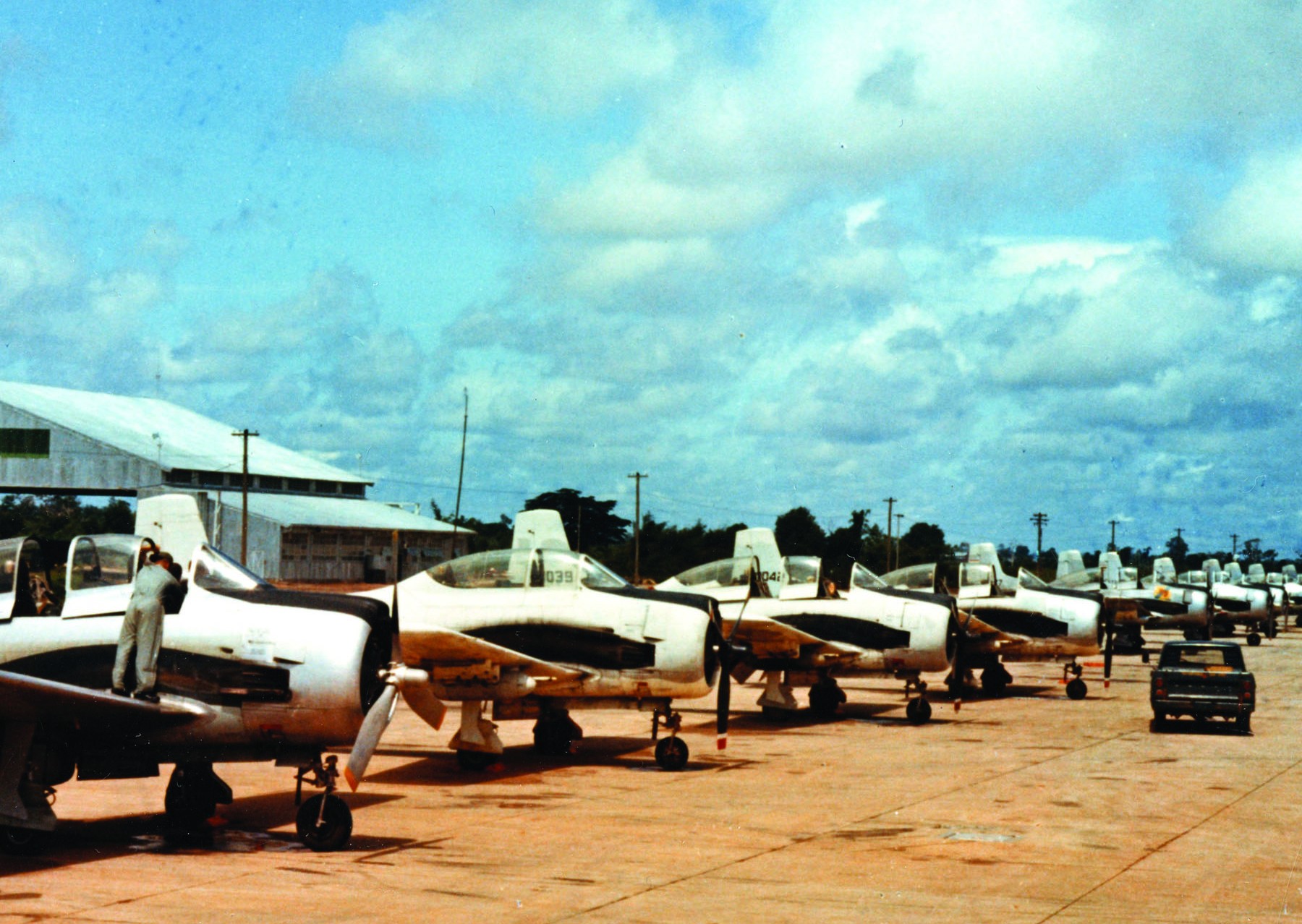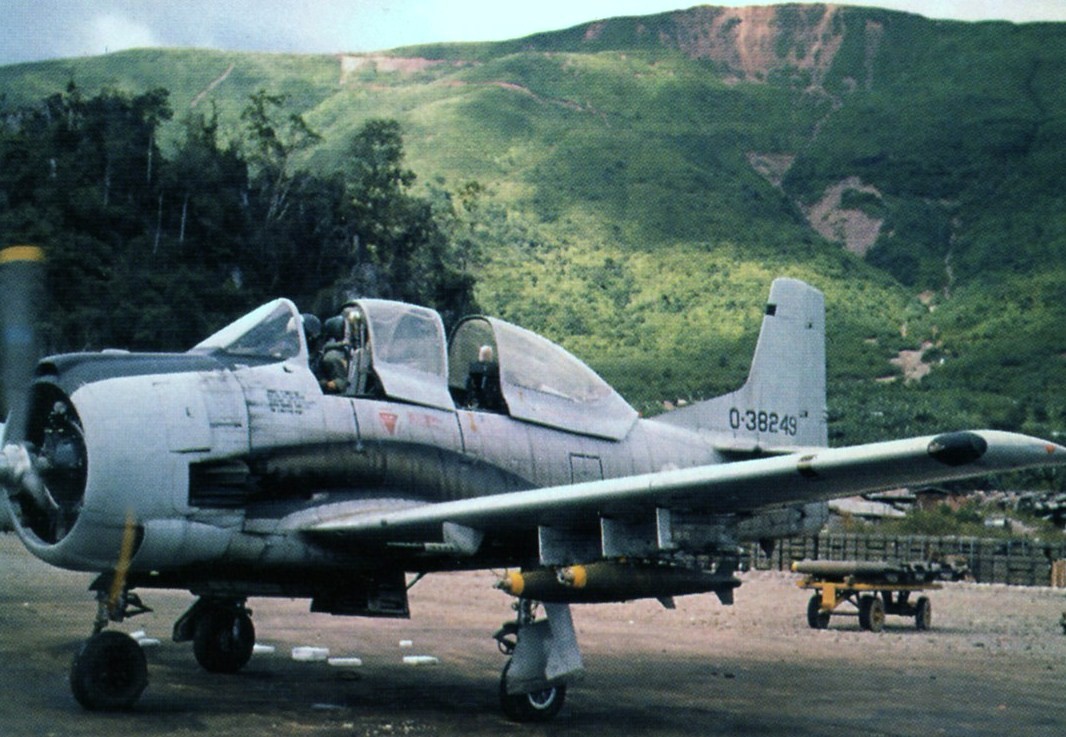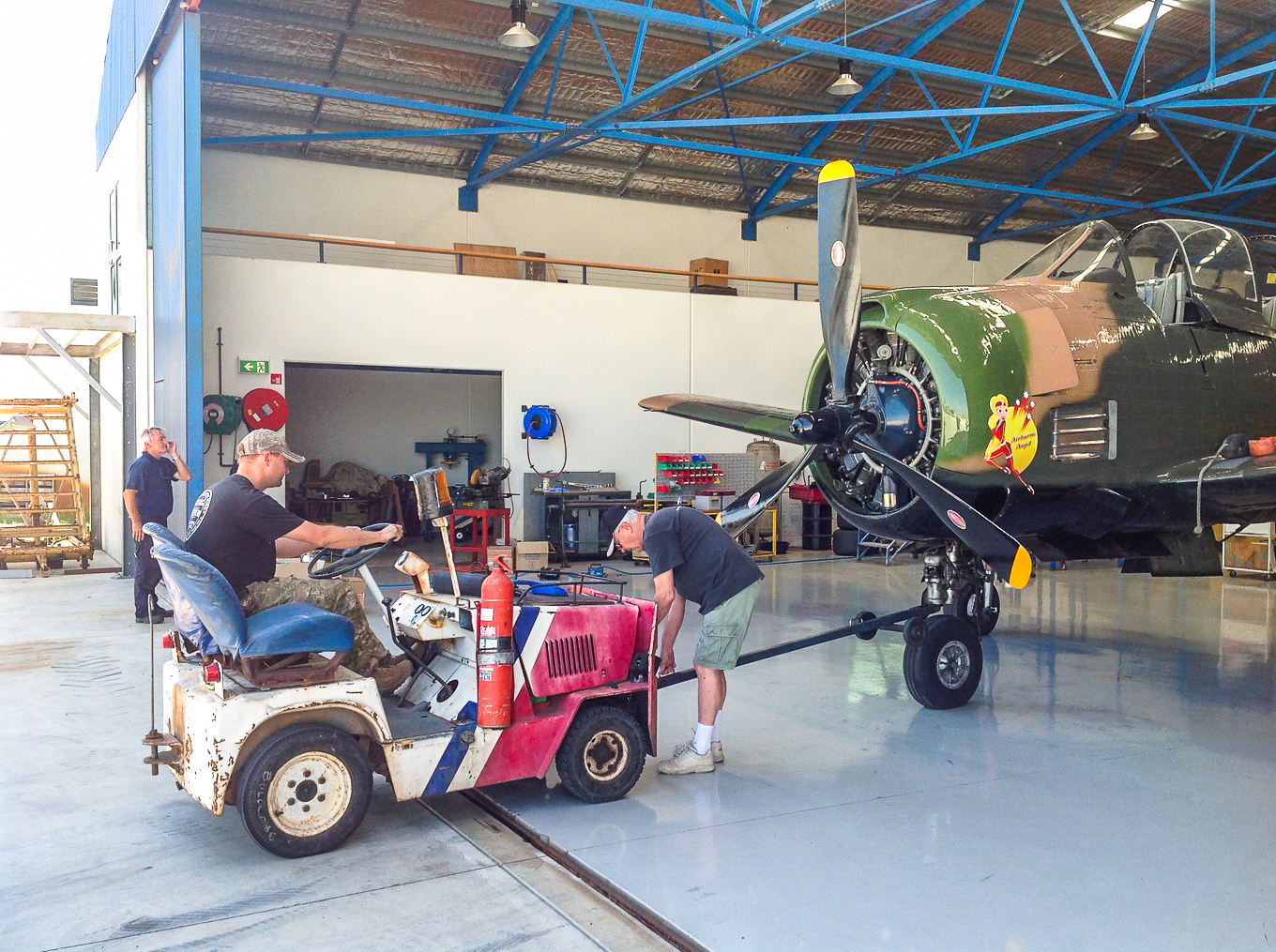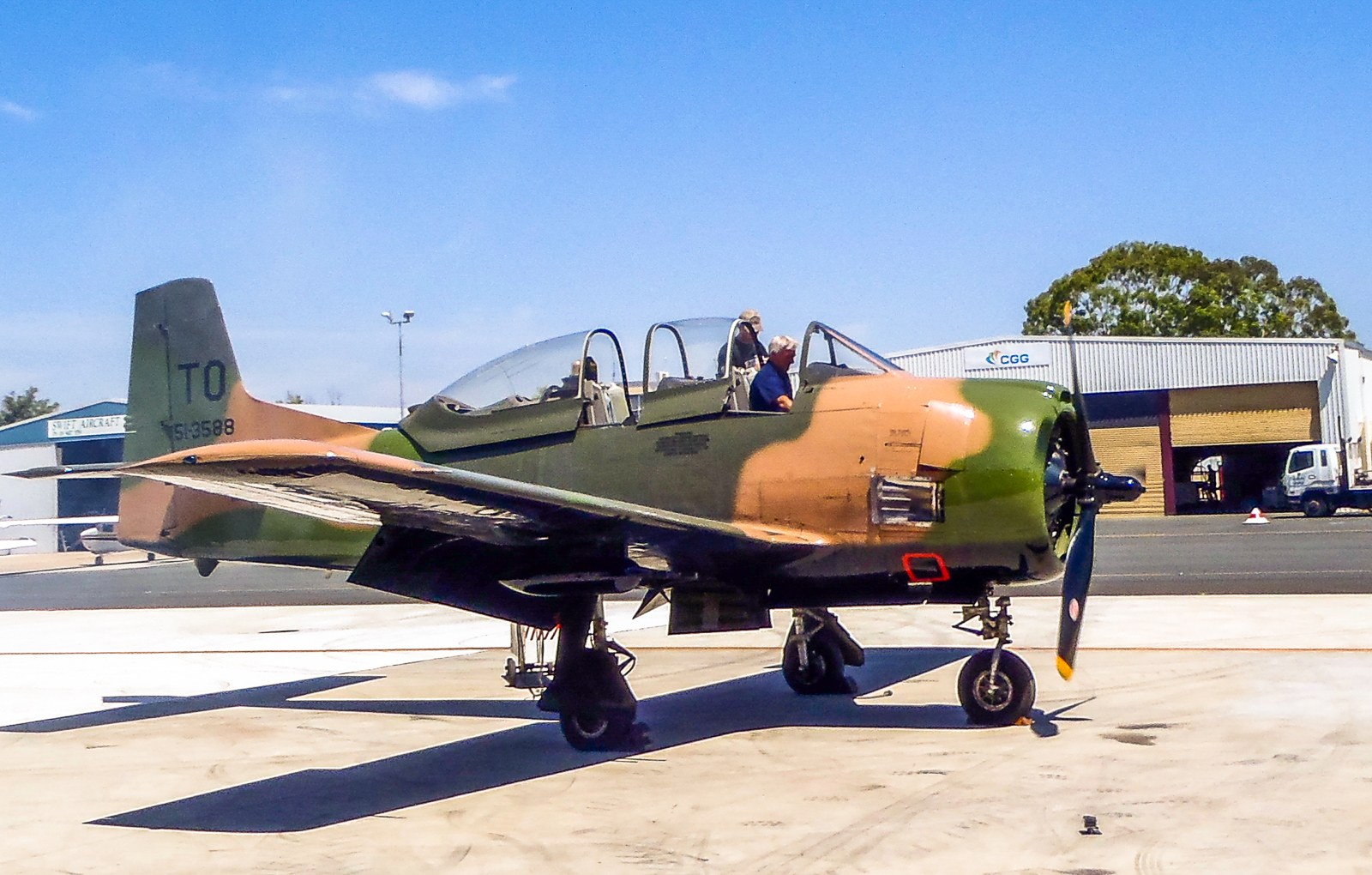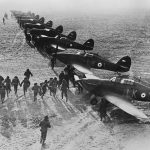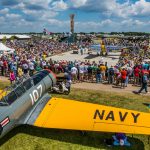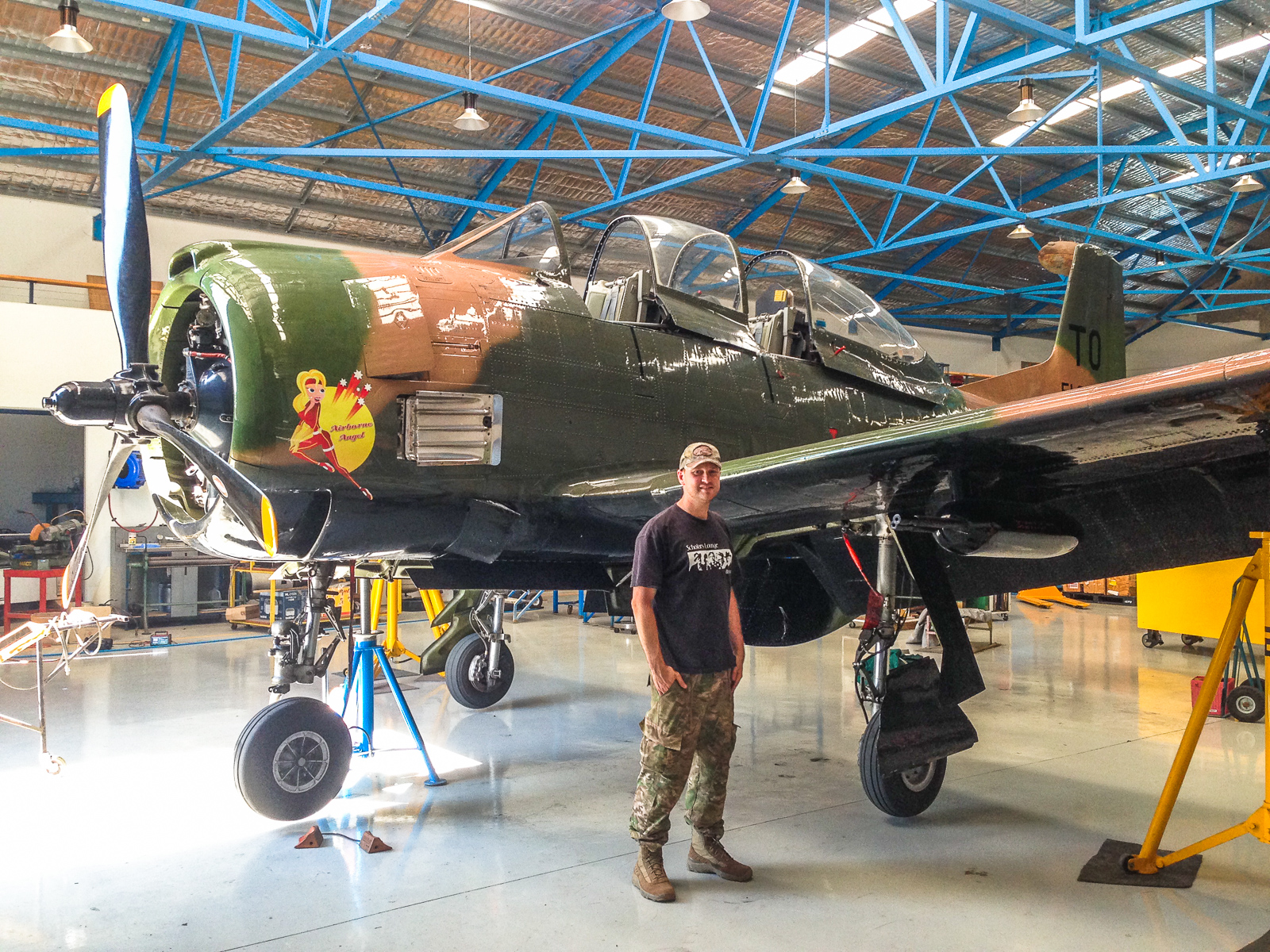
WAR VETERAN T-28D TROJAN WARBIRD MAKING A COMEBACK
Story by Phil Buckley with information/photos supplied by Chris Godfrey
Speaking exclusively with WarbirsNews, Australian pilot and warbird enthusiast Chris Godfrey discusses some of the history around his Viet Nam war-era T-28D Trojan and the latest update on getting his prized possession back into the air. Registered as VH-PFM, Godfrey’s T-28D Trojan has been a popular participant at airshows over the last two decades in New South Wales and more recently in Western Australia. It hasn’t flown in a few years though, and is currently being refurbished. Once re-flown, it will move from its current hangar in Western Australia to Godfrey’s home in Victoria, southeastern Australia. Unusually, Godfrey’s aircraft is marked with a Viet Nam War-era four-colour camouflage scheme – something which stands out in comparison to other Australian-based T-28s which are mainly painted in training or non combat schemes. The camouflage livery gives some clues to its former life though…..
EARLY LIFE
VH-PFM’s long life can be traced back to its manufacture under a U.S. Air Force contract in the early 1950s. It entered service as T-28A Trojan 51-3588, operating in the advanced trainer role initially. North American Aviation upgraded the Trojan to T-28D status in the 1965 at their plant Columbus, Ohio. Between 1961 and 1969, NAA transformed over 390 T-28As into T-28D models. The modifications included an improved Wright R-1820-86B engine and strengthened wings spars to allow a bigger weapons loading among other things. These upgraded aircraft were intended mainly for service in foreign air arms in the COIN (COunter INsurgency) role. T-28s were well-suited for light attack and FAC (Forward Airborne Controller) operations….. such as those developing then in South East Asia. 3358 was the 130th Trojan T-28D conversion on the Columbus, Ohio production line. After its upgrade, “3588” served with various units in the US, where it rotated between storage and training combat crews in the late 1960s at both McClellan and Keesler Air Force Bases.
COMBAT SERVICE – LAOS
The US Government allocated 3358 to the Military Assistance Program by 1970 at the latest, as it was in service and being maintained by Air America at Royal Thai Air Force Base Udorn in Thailand. It may also have flown under AIRA/US Air America control. These flights were directed by the USAF Attaché, Vientiane then the capital city of the Kingdom of Laos. During 1970 “3588” concluded its US service in Thailand. The aircraft officially joined the Royal Lao Air Force (RLAF) in early January 1971 as serial number 3405 under another MAP program. It reportedly operated as a Raven FAC aircraft, guiding airstrikes and also attacking ground targets itself. Then in 1972, the story gets a little complicated as the Trojan was reported as being shot down by enemy ground fire on operations. Apparently the aircraft was not damaged too badly though, as the military salvaged and rebuilt her back into operational condition again by late 1972. She rotated between Laos and Thailand for maintenance over the next few years and was still in active service in early 1975. She continued to serve up until April 1975, when the Royal Lao Air Force flew its last ever combat mission. Soon after the RLAF ceased to exist, as the Pathet Lao forces won the civil war which had been in full sway since 1960. The new Laotian government took control of the RLAF’s assets, renaming the air arm the Lao People’s Liberation Army Air Force. Most RLAF crew were initially imprisoned, but some were released to fly retaliatory strikes against the Hmong people in the years immediately following the civil war. T-28D Trojan 51-3358 may have been involved in those missions against the Hmong in 1976/77.
DOWN UNDER – A NEW LIFE AS A WARBIRD WARRIOR
After she retired from active military service, most likely in the late 1970s, the Trojan sat quietly decaying until noted Australian warbird enthusiasts Col Pay and Noel Vinson acquired her as part of a syndicate along with fifteen other former RLAF examples and other types in 1988. The syndicate had the aircraft disassembled and trucked from Xiang Khoang, Laos to Bangkok, Thailand from where they were shipped to Scone, NSW in Australia. Once in Australia, specialists rebuilt her back to airworthy status. Bill Hamilton acquired the aircraft and registered her as VH-PFM in 1993. He had the Trojan painted with a USAF Viet Nam War-era paint scheme with a “TO” tail code in honour of the 606th Air Commando Squadron, which flew missions over South East Asia out of Nakon Phanom, Thailand. The Trojan enjoyed more than a decade on the air show circuit before undergoing another rebuild in 2008 for a new owner in Perth, Western Australia. She flew at air shows and other events up until 2012 when she again went on sale; being bought by Chris Godfrey in Victoria.
VETERAN WARBIRD UNDERGOES REPAIRS TO FLYING STATUS
Chris Godfrey has a passion for warbirds and in 2012, he purchased his first warbird aircraft – a T-28D Trojan. The aircraft has been stored in a hangar since then, undergoing refurbishment as time permits. Godfrey wants to fly the aircraft to help educate people about the Viet Nam War. Little known to many in the West, Australia played a significant role in Viet Nam, with a strong commitment of men and materiel to the campaign from 1962 to 1972. Some 60,000 Australians served alongside US and Southern Vietnamese personnel during the conflict. Godfrey talked to regular WarbirdsNews reporter, Phil Buckley, recently about his plans to bring the Trojan back to flying condition. Chris Godfrey chose to purchase the T-28 partly because it is a great mid-size warbird with nice speed and a radial engine. He was very interested in buying this example, due to it having a combat history in the Viet Nam War. He considers this part of its operational life to be a “real slice of history” which not only he but others can learn from.
Godfrey tells WarbirdsNews that, “After nearly two years of no flying, my aircraft … has recently had some work to bring her back to life. This work is being done in anticipation for a ferry flight soon to Victoria”.
With a new propeller soon to be overhauled and delivered to the aircraft’s current hangar in Western Australia, Godfrey continued, “Recently we spent a few days working on the aircraft, which saw us jack it up and cycle the landing gear, while checking also for any major hydraulic leaks. I also had the engine checked, started it, followed by run ups”. The T-28 has not flown for quite a while, so all of these checks are required to ensure the systems are functioning properly.
Chris Godfrey recalls that, “It all went very well over the two days and the Engineer was quite pleased, as was I.” Godfrey’s goal is to return the veteran warbird to flight, but unfortunately before the aircraft goes anywhere it will need further work done to it. It needs three overhauled propeller blades added to the bill The propeller replacement program is currently underway, which Godfrey says is a bit of a challenge due to the logistical nightmare of the aircraft being so far from his home in Victoria. Godfrey notes that, “The propeller hub and old blades have to be shipped all the way from Perth (west coast) to Melbourne (east coast) to be mated up with the new blades (which are coming in from the US) to be installed on the hub. After that, the entire prop unit has to be taken back to Western Australia to be fixed onto the prop shaft.” This is a slow process, but an important part of Chris’s dream to have the warbird in operational condition. Once the new propeller is installed, the engine can be tested again along with a functional check flight. This will hopefully then allow Chris to begin the fun part… the long ferry flight to Victoria.
AIRSHOWS AND FUTURE PLANS
Chris Godfrey plans that once in Victoria, “The Trojan will be safely put in my brand new hanger and cared for.” Godfrey continued that his plans for the future, “will include anything that keeps it in the air, including first; flying it! along with air show appearances, fly-ins and hopefully being ready to go to the Temora Aviation Museum’s Warbirds Downunder 2015”. Longer term, Godfrey hopes to offer adventure flights for the general public to ride and experience the thrill of the migthy Trojan in flight. He also intends to keep the Viet Nam War-era paint scheme, as it is a connection to a war he has a big interest in and it is a unique paint scheme in the Australian T-28 Trojan warbird community. Many thanks to Chris Godfrey for allowing an insight into his warbird. We wish him all the best with its return to flight in 2015.








